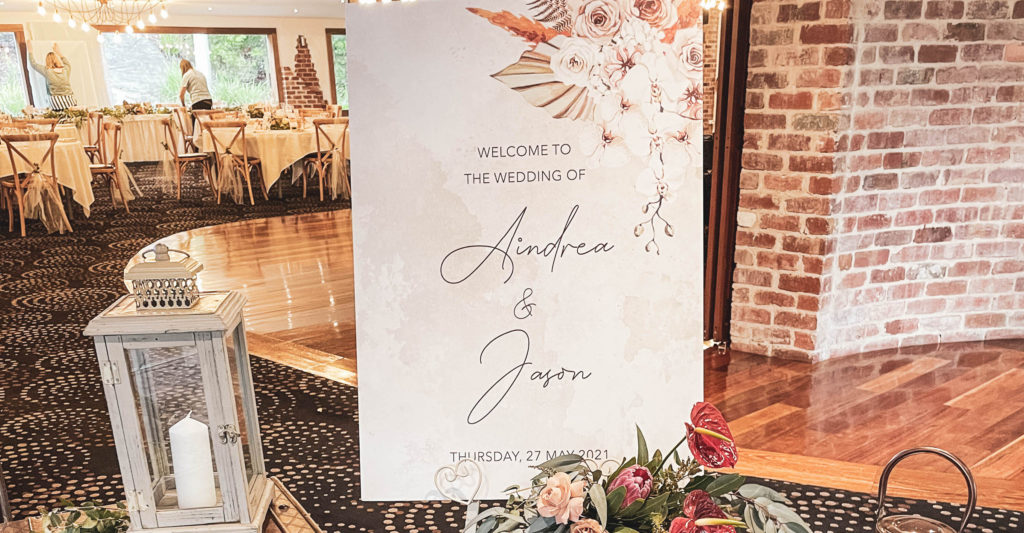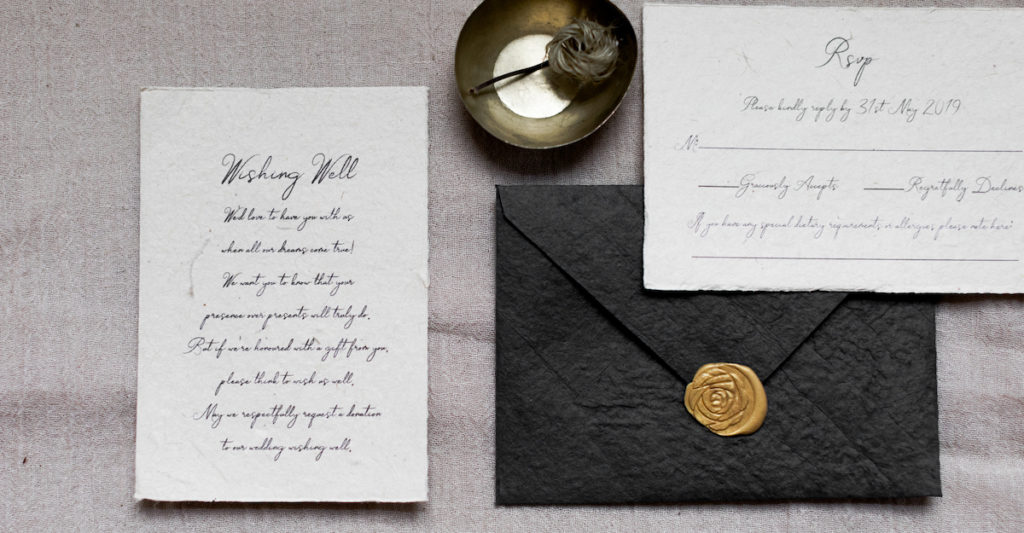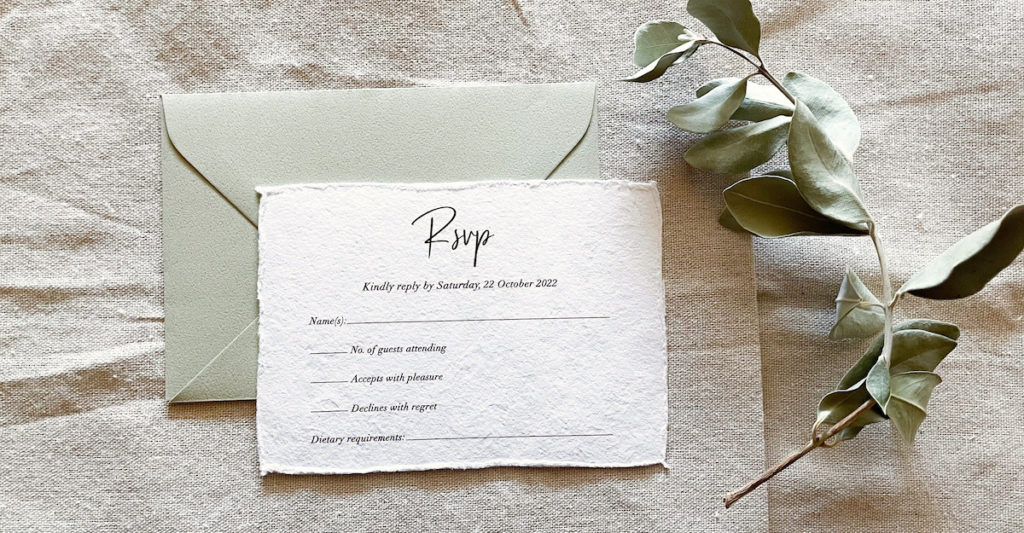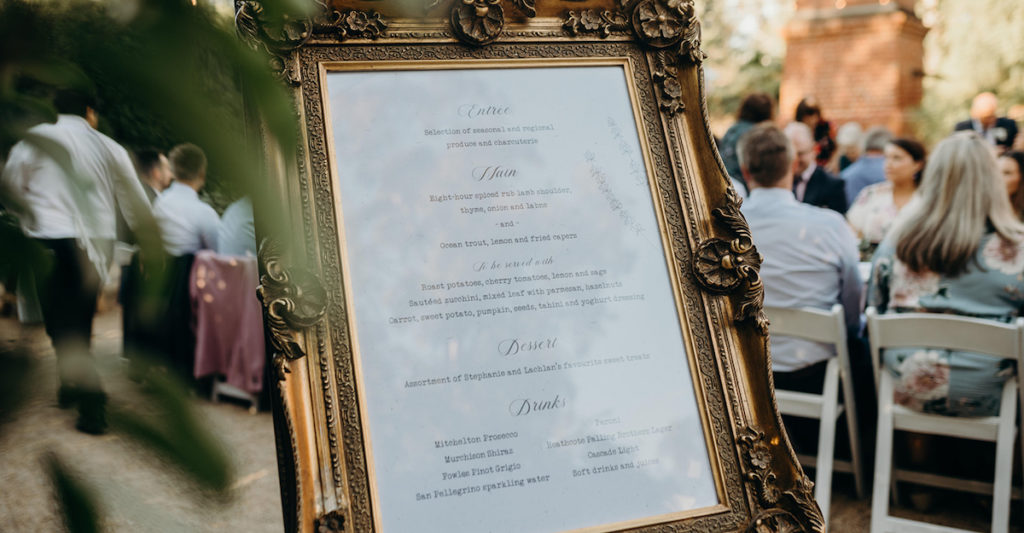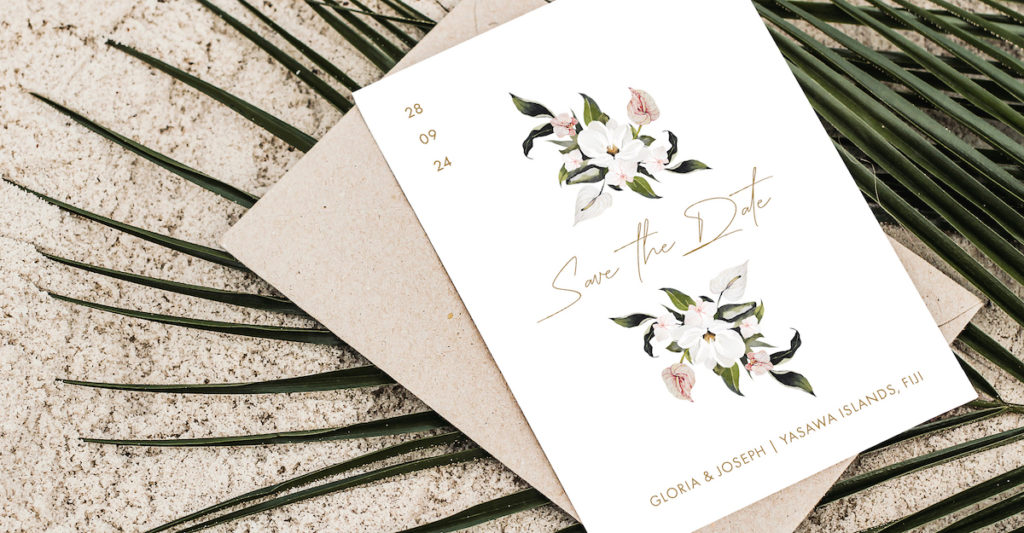This article was last updated on 15/11/2025.
If you’ve decided to DIY your invitations and have bought a template — congrats, the fun part begins now! One of the best things about using templates is that you’re free to word your invitation however you like, without worrying about designer revision limits or awkward formality.
But let’s be real — even the most beautiful template can leave you staring at a blank text box thinking, “What do I actually write?” Whether you’re after something traditional, modern, or completely your own, this guide covers the basics of wedding invitation template wording.
Wedding Invitation Wording
Before you get into the how of wording, it helps to know what actually needs to go on a wedding invitation. Whether you’re keeping things minimal or going fully formal, there are a few key details every invite should include. These details are important so your guests know exactly where to be, when, and why.
It’s also useful to think about the tone of your invitation before you start writing. Are you aiming for something traditional, relaxed, playful, or poetic? Having a clear idea of this will make the wording process feel much more natural and help your invitation reflect you as a couple.
Download the printable A4 version of this wedding invitation template wording cheat sheet here

The Essentials
Your Names
This one’s a given—it’s the who. Depending on the tone you’re going for, you can go as formal or casual as you like — from full names to something relaxed and simple.
The Occasion
It sounds obvious, but it’s important to actually say what guests are being invited to — a wedding ceremony, a reception, a bbq, a post-elopement celebration, etc. This is especially helpful for modern or non-traditional events where the format might differ.
The Date and Time
The second most important detail is the when. Write it out in full for formal invites or keep it simple for casual designs.
We recommend including the day of the week too — weddings are often assumed to happen over a weekend, and if yours falls on a weekday, guests might miss that if it’s not clearly written.
The Ceremony Location
Next, be clear about where everything’s happening. If your ceremony and reception are at different locations, include both — it helps guests plan transport and timing. If you’re expecting interstate or overseas guests, it’s best to list the full venue address to avoid confusion. (Some places share very similar names — and no one wants guests turning up to the wrong Westin Hotel in another state.)
RSVP Details
And finally: how should your guests respond, and by when? Include your RSVP deadline and the method of response — this can be as simple as a line at the bottom of the invitation. You can also direct guests to a wedding website, email address, or physical return card — whatever suits your setup best.

Optional Extras
These depend on your style, guest list, and how much information you want to include:
- Dress code – Helps your guests plan ahead and prepare a suitable outfit.
- Dress suggestions – For less obvious dress codes like “garden formal” or “beach chic,” a bit of clarification can go a long way.
- Parents’ names – We hardly see this on modern invites these days, but it’s helpful to include if you’re going with traditional wording or if your parents are hosting.
- Reception details – Important if you have timing or instructions for your reception, so guests can prepare accordingly.
- Gifts or wishing well information – You can briefly mention a wishing well, registry, or note that no gifts are expected.
- Children – Clarify if children are welcome or if you’re having an adults-only celebration — it avoids confusion later.
- Accommodation details – Ideal for out-of-town guests or if you’ve secured accommodation for everyone; you can suggest nearby hotels or group bookings.
- Transport details – Helpful if you’re providing transport between venues or have limited parking options.
- Itinerary – Useful for weekend weddings or events with multiple parts, such as welcome drinks or recovery brunches.
- Wedding website – Handy for housing all the nitty-gritty details in one place (especially if space is tight on the invite). If you’re after a website, we recommend WedSites — an Aussie-based platform that’s clean, easy to use, and built specifically for weddings.
- QR code – Becoming increasingly popular for linking directly to RSVP forms or wedding sites.
- Meal preferences – Only needed if you’re asking guests to choose meals in advance.
- Weather advice – For outdoor weddings, it’s helpful to mention things like “bring a jacket” or “heels not recommended.”
- Social media note – A polite mention if you’re requesting an unplugged ceremony or sharing a wedding hashtag.
- Contact number on the day – Optional, but helpful if someone gets lost or needs help.
Wedding Invitation Template Wording Examples
Traditional / Formal Wording
(For a formal or classic style wedding)
Together with their families
Sally Patricia Warton
and
William James Marshall
request the honour of your presence
at their marriage ceremony
on Saturday, the Twenty-seventh of October
Two Thousand and Twenty-nine
at two o’clock in the afternoon
St Paul’s Cathedral
200 Flinders Street, Melbourne VIC 3000
Reception to follow at five o’clock
Westin Room III
The Westin Melbourne
205 Collins Street, Melbourne VIC 3000
Dress: Black Tie

Casual or Modern Wording
(Relaxed, contemporary tone for a modern wedding)
Sally & Will
are getting married!
Join us to celebrate
on Saturday 27 October 2029
at 4 PM
Trinket Bar
87 Flinders Ln, Melbourne VIC
Cocktails, dinner and dancing to follow
Dress: Cocktail Attire

Elopement Announcement or Invitation
(For a private ceremony with optional gathering)
We got married!
Sally & Will
eloped on 27 October 2029 in Fiji
We’re keeping things simple,
but we’d love to celebrate with you soon.
Stay tuned for party details!
OR (if inviting to an elopement):
We’re eloping!
Just us, a handful of loved ones,
and a whole lot of love.
Join us for a private ceremony
on Saturday 27 October 2029 at 4 PM
Tokoriki Island Resort
Nadi, Fiji
Kindly RSVP by 1 March 2029
Intimate or Micro Wedding
(Low-key, heartfelt, small guest list)
With joyful hearts,
Sally & Will
invite you to celebrate their wedding day
with a small gathering of their nearest and dearest
Saturday 27 October 2029
at 4 PM
Goody Two’s
1/40 Irwin St, Perth, 6000 WA
Dinner and a good dance to follow
Kindly RSVP by 1 September
Reception-only Wedding Invitation
(For couples marrying privately but hosting a celebration)
Sally & Will
We got married in a private ceremony,
and now we’re ready to celebrate!
Join us for a wedding reception
to toast, feast and dance the night away
Saturday 27 October 2029
from 6 PM
Panama Dining Room
2/231 Smith St, Fitzroy VIC 3065
Kindly RSVP by 1 September
Wording Tips When Using Editable Templates
Be Mindful of the Space
When adding wording to your invitations, it’s easy to go overboard and end up crowding the template. You might start with something elegant, but too much text can make it feel more like a community announcement in your local newspaper than an invitation. If you have a lot of details to include, we recommend setting up a wedding website or even a Facebook event for guests who prefer that format.
Another option is to print extra information on the back of the invitation, as it often gives you more room than a small details card. You can also make the most of a double-sided details card. The key is to keep the essentials on the main invite and place everything else smartly elsewhere.

Ensure the Text is Legible
As a general rule, avoid going smaller than 6pt font, as anything below that is considered illegible when printed. If your wording forces the font below 6pt just to make it fit, it’s probably a sign there’s too much text. When we design invitations, we typically use 8pt as the minimum and keep body text between 9pt and 14pt. Headings can be larger, depending on the design and layout.
If you have access to a printer, it’s worth doing a quick test print to make sure your text is readable at actual size before sending everything off to print.
Use Script Fonts Sparingly
As beautiful as they are in Pinterest photos, script fonts can be tricky to read — especially when used for long lines of text, small details, or all-caps. Save them for names, headings, or short phrases, and pair them with a clean serif or sans-serif font for balance (Grandma will thank you).

Proofread Your Invitation Like a Guest
Would your invitation make sense to a guest who knows nothing about the wedding? Also, spelling mistakes, typos, and rogue punctuation love to sneak into wedding invitations. Always get a second set of eyes on your design before printing, especially when it comes to names, dates, and venue details.
Conclusion
Writing your wedding invitation doesn’t need to feel overwhelming. Once you’ve decided on the tone and covered the key details, everything else is about making it feel like you. With editable templates, you have the freedom to personalise your wording without the pressure of designer revision rounds. Take your time, keep it clear, and enjoy the process. You’re one step closer to creating something truly special.
Further Reading
Looking for more examples or formal etiquette rules? Here are a few helpful resources to explore:
- A Complete Guide to Wedding Invitation Wording – Brides
A thorough breakdown of traditional, modern, and unique wording options, including examples for divorced parents, hosted weddings, and more. - What to include on a Wedding Invitation – ABIA
Tips on what to include on your wedding invitations from the Australian Bridal Industry Academy
—
Please note that some of the links in this post are affiliate links and any purchase made through the links will give us a small commission (at absolutely no extra cost to you). Please read our Affiliate Disclaimer for more info.


